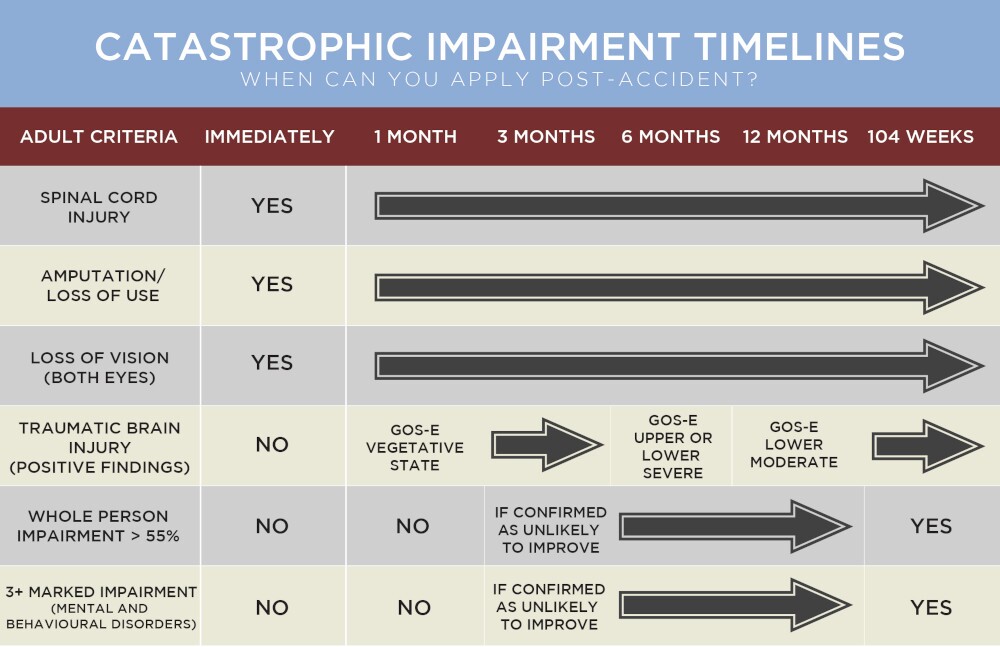- Home
- >
- News and Events
- >
- Classes of Impairment
Classes of Impairment

When a person is injured in an accident in Ontario and pursues a claim for accident benefits, the insurer will, at some point, make a determination as to the degree of their injury and impairment. An injured person may be found to have a minor injury, a non-catastrophic impairment or a catastrophic impairment. The onus is on the injured person to prove the degree of their impairments.
What category an injured person accesses is critical to the claim as the categories will dictate the degree of eligibility and entitlement to many benefits under the policy. Given this, the injured person, the health care professionals involved, and the personal injury law firm must remain attentive to the categorization of injury.
A non-catastrophic impairment may be considered one which neither fits the defined criteria for a minor injury or that of a catastrophic impairment.
When a person suffers severe injury due to a motor vehicle accident, having early access to the highest level of accident benefit coverage is of utmost importance. In order to achieve the highest coverage limit, a catastrophic impairment designation must first be achieved.
The legal definition of catastrophic impairment has become increasingly complex with the passage of time. Legal professionals, healthcare providers, and insurers bear responsibility to be aware of the relevant catastrophic impairment criteria and must pro-actively manage the timing of application for injured clients. Of note, opportunities for catastrophic impairment application may arise at a number of points post-accident and may include: immediately following an accident, at the one, six, nine, and 12 month anniversaries of the accident, or at the 104 week anniversary of the accident or beyond.
Generally speaking a catastrophic impairment may be confirmed if the impairment results from any of the following:
1. Paraplegia or tetraplegia that meets the following criteria:
- The permanent grade on the ASIA Impairment Scale is or will be either an A, B, or C, or
- The permanent grade on the ASIA Impairment Scale is or will be a D, and mobility, urological function, or anorectal function is significantly impaired.
2. Severe impairment of ambulatory mobility or use of an arm, or amputation.
3. Loss of vision of both eyes, with organic cause, even with the use of corrective lenses or medication.
4. If the person was 18 years of age or older at the time of the accident, a traumatic brain injury that meets the following criteria:
- The injury shows positive findings on a CT Scan, a MRI, or any other medically recognized brain diagnostic technology
- When assessed in accordance with the Extended Glasgow Outcome Scale, the injury results in a rating of,
- Vegetative State, one month or more after the accident,
- Upper or Lower Severe Disability, six months or more after the accident, or
- Lower Moderate Disability, one year or more after the accident.
5. If the person was under 18 years of age at the time of the accident, a traumatic brain injury that meets one of
- The person is accepted for in-patient admission to a recognized public hospital with positive findings on a CT scan, a MRI, or any other medically recognized brain diagnostic technology.
- The person is accepted for in-patient admission to a program of neurological rehabilitation in a recognized paediatric rehabilitation facility
- One month or more after the accident, the person’s score on the KOSCHI does not exceed category 2 (Vegetative)
- Six months or more after the accident, the person’s score on the KOSCHI does not exceed category 3 (Severe disability)
- Nine months or more after the accident, the person’s level of function remains seriously impaired such that the person is not age-appropriately independent and requires in-person supervision or assistance for the majority of the waking day.
6. Physical impairment that, in accordance with the AMA’s Guides to the Evaluation of Permanent Impairment (4th edition), results in 55 percent or more physical impairment of the whole person.
7. A mental or behavioural impairment, excluding traumatic brain injury, rated in accordance with Chapter 14 of the AMA’s Guides to the Evaluation of Permanent Impairment (6th edition) that, when combined with the physical impairment score as described above, results in 55 percent or more impairment of the whole person.
8. An impairment due to mental or behavioural disorder that, in accordance with the AMA’s Guides to the Evaluation of Permanent Impairment (4th edition), results in a class 4 impairment (marked impairment) in three or more areas, or a class 5 impairment (extreme impairment) in one or more areas.
To learn more about the Glasgow Outcome Scale, please click here.
Accessing a claim for catastrophic impairment is of significant importance in terms of increasing eligibility and entitlement to accident benefits.
To pursue a catastrophic impairment designation, an Application of Determination of Catastrophic Impairment form should be submitted to the insurer along with supportive medical documentation. It is usually required that the application be prepared by a physician, who may be assisted by other regulated health care professionals as may reasonably be required. The exception to the rule is when the impairment is a traumatic brain impairment only, in which case, a neuropsychologist may prepare the application with the assistance of other regulated health care professionals as may be required.
Once the insurer has received the application for catastrophic impairment, it has 10 business days to give the injured person notice regarding whether it agrees that the impairments meet the definition of “catastrophic impairment.”

